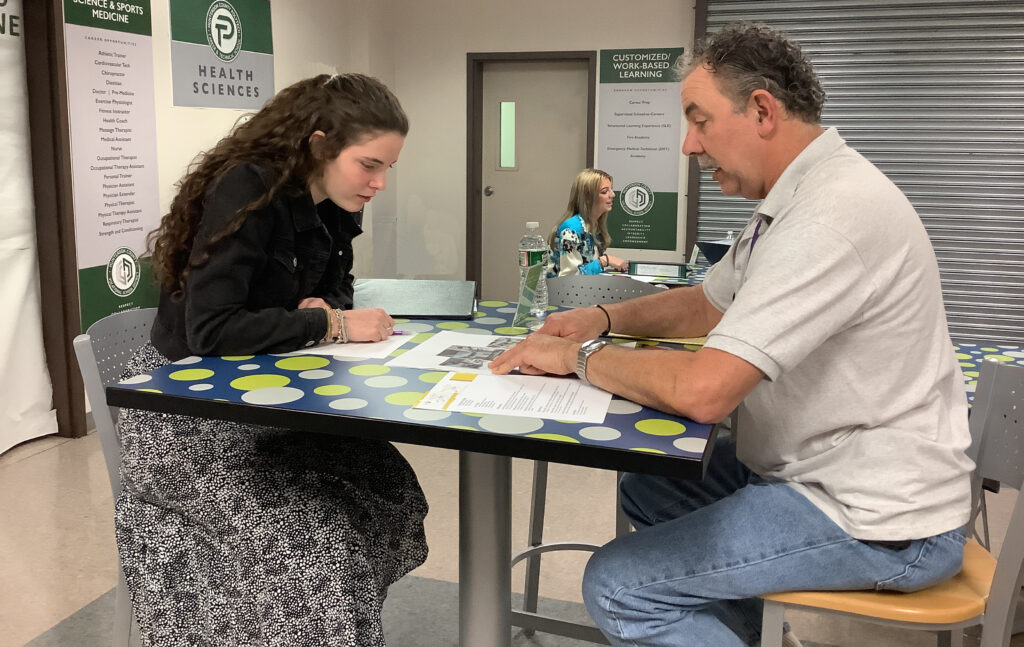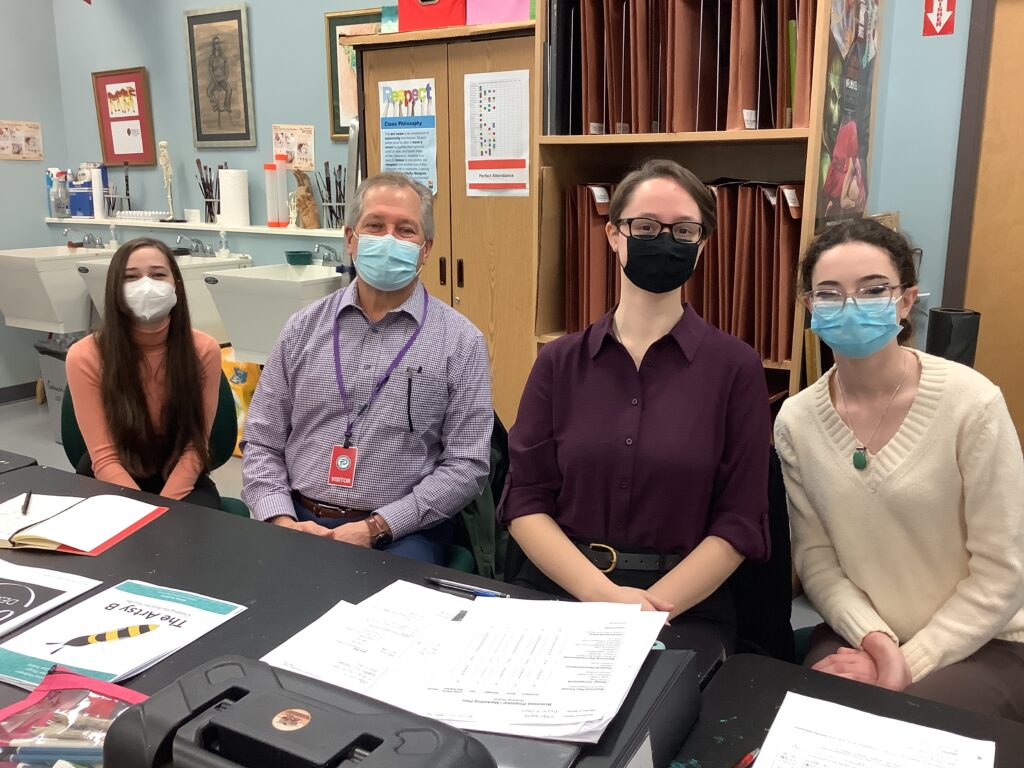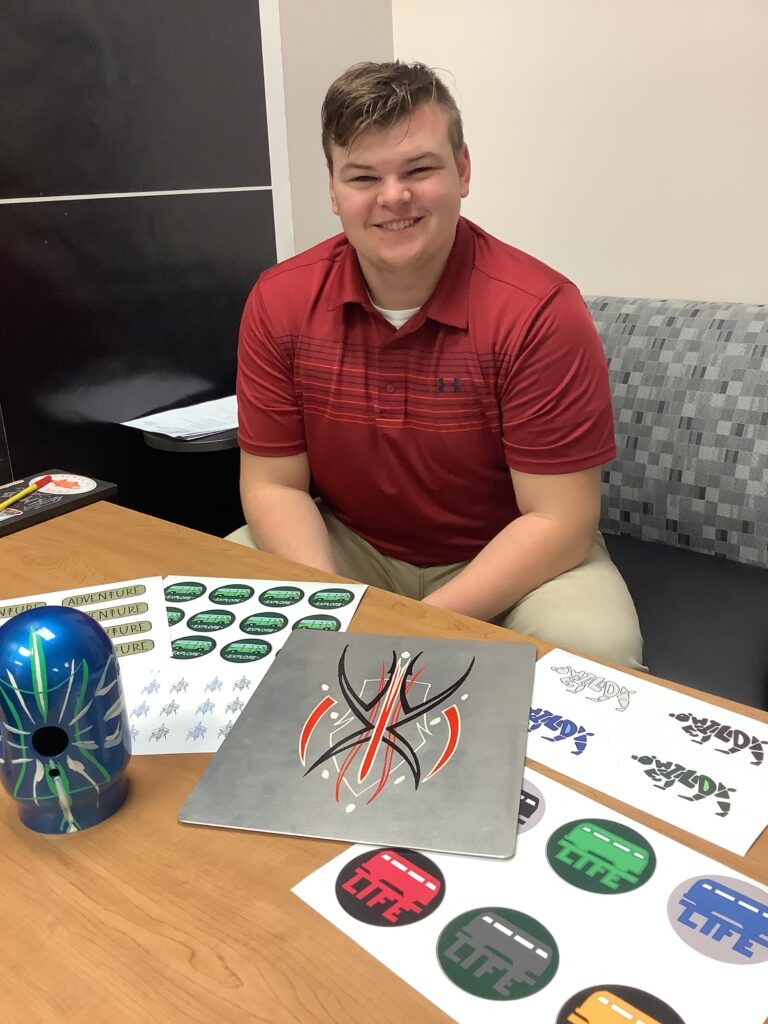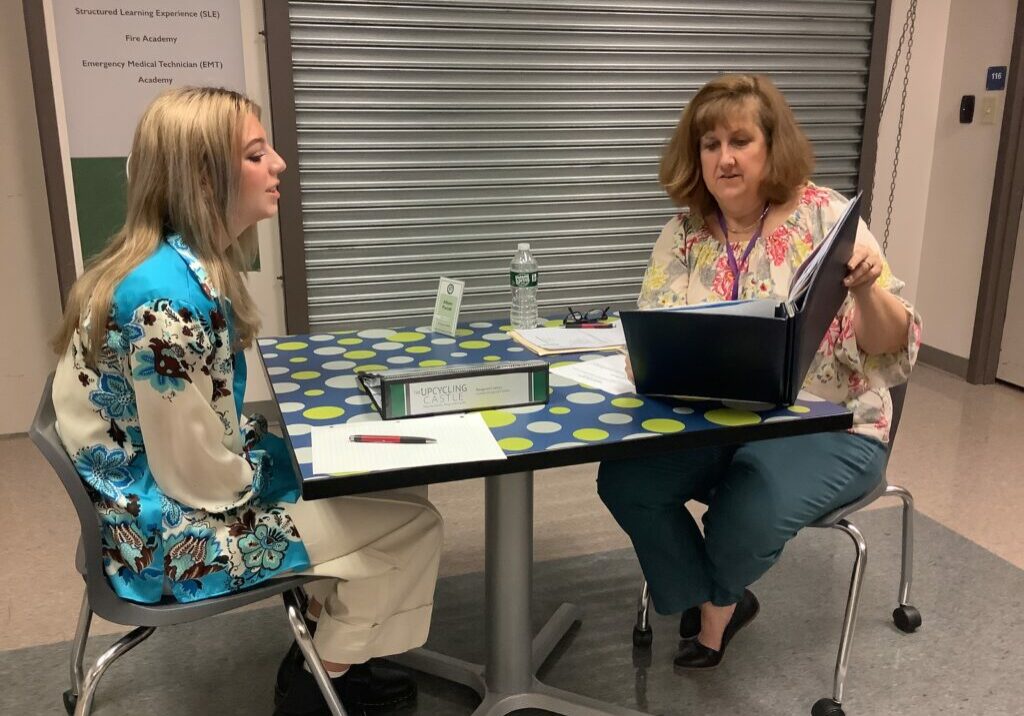Innovative program bridges the gap
By Kathryn Coulibaly
Teresa De Sapio Diaz has always been an artist. The commercial arts/advertising design and 3-D computer animation teacher grew up in Hunterdon County and was inspired to pursue a career in art out of college. She opened her own business, TADS – Art & Illustration, which she continues to run even as she enters her 24th year of teaching at Hunterdon County Polytech Career and Technical High School, raises four children, and teaches art at night to adults.
As an artist and a business owner, she knows the importance of teaching her students business skills. Thirteen years ago, she began a partnership with local Rotary clubs through the Bridging the Gap program. The program originated with a marketing teacher, but it eventually migrated to the art department, and Diaz has been running it ever since.
“We started this program as a way to help our students learn how to start their own businesses as artists,” Diaz said. “We give them the practical skills they need to take themselves seriously as artists and business owners, and we introduce them to people who can make that dream a reality.”
The program is for first- and second-year commercial arts/advertising design students. During the first semester, Diaz introduces them to the various career possibilities they can pursue in art, such as mural painter, jewelry designer, graphic artist, and many others.
In January, the students decide what area they want to pursue, but it has to be a career they can pursue immediately with the skills they currently have to offer.
After they make their selection, they are paired with local Rotary Club mentors from the Clinton Sunrise, Whitehouse, North Hunterdon, and Flemington clubs. The mentors work with students one-on-one for two months to help them develop a 16-page marketing plan that includes elements such as their business’s name, slogan, what services the business will offer, who the target market is, what the total market would be, marketing strategies, pricing, who their competition would be, what their competitive edge would be, and samples of their work.
“Our mentors are all members of local Rotary clubs, and one of Rotary’s aims is the support of education, especially vocational education,” said Len Yacullo, a member of one of the participating Rotary clubs and a long-time mentor with the program. “Being able to assist these talented students with our knowledge of business has proven to be an outstanding partnership between our clubs and Hunterdon County Polytech.”
Together with the Rotarian, the student designs and builds a website and social media accounts, designs their own logo and business card, and develops their resume. By the last week of March, they are ready for a community job fair where they will interview for freelance jobs.
“Working with the Rotarians is such an invaluable experience for our students,” Diaz said. “As adults, we sometimes take for granted all the things that we know. Even at that first mentor meeting, we have to prepare the students for how to dress professionally, how to greet their mentor. I’ll have the students show me outfit ideas on their phone to make sure it’s appropriate before that initial meeting. We’ve had whole lessons on what is appropriate business attire.”
After the first mentor meeting, Diaz works with the students to write a professional email thanking the mentors for their time and mentioning a specific piece of advice that was useful to them.

Learning the business of art
Thirteen years into the program, the freelance job fair is well-known in the community, but the Rotary clubs and Hunterdon County Polytech Career and Technical High School do an excellent job promoting it to potential employers in the community. The job fair attracts a variety of businesses interested in a variety of design needs, such as website design, illustration, graphic design, social media marketing, art therapy products, pet portraits, fashion, jewelry, T-shirts, menus, brochures, banners and tattoo design.
“Each year, we never know who is going to come,” Diaz said. “Sometimes, it’s authors who need a book illustrated or hospitals that need a logo for an event. About a week before the event, we have a list of employers so the students can research them and be prepared.”
The actual job fair is a lot like speed dating. Employers sit at a table and students sit across from them with their portfolios and discuss their work and the employers’ design needs. Every student interviews for every job.
“Students are very, very nervous at first,” Diaz said. “After a while, they say it gets easier. And they get better with each interview. They leave the employers with a copy of their resume, business card, and sample sheet with their artwork. The employers rank their top three candidates and call and offer them the job.”
After the career fair, the students can accept one offer, so they learn how to accept and how to reject a business opportunity. They also have to negotiate a price and write a legal contract, including deadlines and a deposit.
Their Rotary mentor and Diaz are available to them every step of the way. Diaz assists primarily with the art side of the equation, and the Rotarian assists with the business aspects.
“One of the biggest takeaways for students is time management,” Diaz said. “But they also learn how to communicate effectively with the client about art, how to take a critique, and how to get on the same page. They learn that, ultimately, they have to satisfy the client’s needs.”
Diaz finds that when a student runs into problems, it’s actually a great learning experience for them. They ultimately find that it’s so rewarding for them to solve the issue and they learn perseverance.
“I love guiding them through that,” Diaz said.

Rotary Club mentors guide student-artists
At the end of the project timeline, which runs about six weeks, they hold an awards ceremony that the students, mentors and clients all attend. The students present the projects and the Rotarians determine which student has done the best and present them with a $500 scholarship.
The mentors gain a lot of satisfaction from working with the students and can be quite competitive about whose student wins the scholarship.
“I love working with the students,” said Megan Jones-Holt, a long-time mentor and a founding Rotary member. “They are so bright-eyed, but in one hour we turn their heads just by asking basic questions and getting them to understand that you have to make money. We really make them focus on the business side. I also love the competition between the students presenting their projects. For me, it’s about my mentored student coming out on top—which I have to brag and say that over the 27 years I’ve been working as a mentor, my student has won 90% of the time!”
Whether they win the scholarship or not, many students decide to maintain their businesses, even after graduation. They find that it helps them pay for college, even as they continue in the field they love.
“One of my students is a jewelry design major in college running her ‘Bridging the Gap’ business in college and another alumna is a graphic design major running an online store designing wallpaper for iPads and phones,” Diaz said.
The portfolio they produce through the program also helps them when applying to college, and the confidence and skills in interviewing are an asset no matter what they decide to do.

Making a living through art
The students are enthusiastic about the program and the skills it brings.
“The thing I enjoy the most about Bridging the Gap is getting to explore new career path plans,” said Mary K. Parente, a Bridging the Gap participant. “It helped me think about what I would enjoy doing in the future and what I can do about it now. During the process, I learned about how to market not just my products and company but myself as an artist. The program helped me prepare for my future by giving me real world experience as well as teaching me what I don’t want to do in the future in a space without real consequences.”
For student Henry Cooper, it gave him a practical argument for studying art, a subject he loved.
“I really enjoyed having the total creativity to make my own business the way I wanted. I learned how to contact and talk to clients. By doing Bridging the Gap and studying at Polytech, as a whole, I have changed my mind about college and decided to study art, as well as science. Bridging the Gap has allowed me to rekindle my love for art.”
For Diaz, helping students find a way to keep art in their lives is an added benefit.
“It’s so amazing to have a career as an artist,” Diaz said. “I’m always looking at life through an artist’s lens. Even after 23 years of teaching, I think that’s why I’m still so excited about teaching; I come to work happy every day because I’m still an artist and I come to school with that energy. The students know it and feel it.”
Diaz’s students and colleagues certainly feel it; in August 2021, she was named the Hunterdon County Teacher of the Year. She continues to bring energy and enthusiasm to her many roles in and outside of school.
Many schools partner with local Rotary clubs and other community service organizations to benefit their students. Learn more about if there is a Rotary club in your area at njrotary.org.
